Are you considering bringing a fluffy, energetic, and loving Labradoodle puppy into your home? As you start looking into adopting a Labradoodle, you might quickly find yourself navigating a sea of terms like F1, F1B, F2, and F2B. It can get confusing, right? These terms reference the Labradoodle’s generation. You see, Labradoodles come in various generations, each with its own set of characteristics, especially when it comes to their coat type, shedding, and hypoallergenic properties. Today, let’s look at one particular generation that stands out for its unique qualities: the F1B Labradoodle.
In this post we’ll cover not only the basics like temperament, care needs, and health but also dive into what sets this generation apart from the rest.
F1B Labradoodle Quick Facts
| Factor | F1B Labradoodle Characteristics |
| Size | Miniature (14-16 inches, 15-25 lbs) Medium (18-20 inches, 30-45 lbs) Standard (22-24 inches, 50-65 lbs or more) |
| Temperament | Intelligent, Friendly, Adaptable, Good with children |
| Coat Types | Wool (Curly, Hypoallergenic), Fleece (Wavy to Curly), Hair (Straight, may shed more) |
| Grooming Needs | Regular grooming needed, especially for wool and fleece coats |
| Activity Level | High; requires regular exercise and mental stimulation |
| Lifespan | 12-15 years or more |
| Allergy Friendly | Yes, if they have curly wool coat |

Understanding Labradoodle Generation
Understanding the alphabet soup of doodle generations can feel like decoding a secret message, but once you get the hang of it, it’s pretty straightforward.
- F1 Labradoodles: This is the first generation labradoodle, where “F” stands for “filial.” An F1 Labradoodle is the direct offspring of a purebred Labrador Retriever and a purebred Poodle. These pups tend to have a 50/50 mix of both parents’ genes, leading to a wide variance in coat types, including fleece coats, wool coats or hair coat, making the hypoallergenic quality a bit of a gamble.
- F1B Labradoodles: Here’s where our star, the F1 B Labra doodle, enters the stage. The “B” stands for “backcross.” An F1B is the result of breeding an F1 Labradoodle back with a purebred Poodle. This generation is approximately 75% Poodle and 25% Labrador genetic makeup, enhancing the Poodle’s traits, especially the curly, low-shedding coat. This makes the F1B a popular choice for families with allergy concerns.
- F2 Labradoodles: These are second-generation Labradoodles, produced by breeding two F1 Labradoodles together. While you might expect a doubling down on desirable traits, the reality is that F2s can have an unpredictable mix of characteristics, including coat type and shedding, making them less consistent than F1Bs in terms of hypoallergenic qualities.
- F2B Labradoodles: Adding another layer, the F2B is a backcross of an F2 Labradoodle to a Poodle, aiming to reclaim some of the Poodle’s non-shedding coat qualities that might have diluted in the F2 generation.
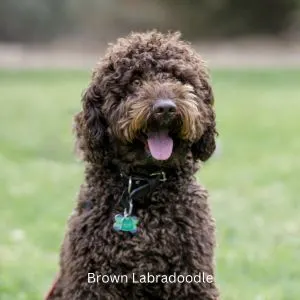
What is an F1B Labradoodle
When it comes to the F1B Labra doodle, it’s like getting a little bit of both worlds, but with a twist that leans heavily towards the Poodle’s side. Let’s take a closer look at the F1B Labra-doodle and how it differs from the other Labradoodle generations.
F1B Labradoodle Temperament
The F1B Labra-doodle combines the Poodle’s sharp intelligence and loyalty with the Labrador Retriever’s amiable disposition, creating an ideal companion for both families and individuals. This blend results in a dog that not only has an affectionate nature but is eager to please. They are also remarkably adaptable to various living situations, thanks to a slightly higher proportion of Poodle genetics.
These dogs excel in learning and problem-solving, making them easily trainable and particularly effective in roles that require empathy, such as a therapy dogs, service dog or guide dog.
Despite their slightly reserved side—a trait likely inherited from their Poodle lineage—they maintain a friendly demeanor, balancing playfulness with the calm needed to fit into a range of environments.
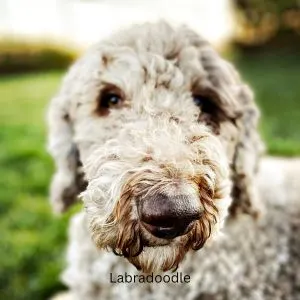
F1B Labradoodles Physical Characteristics
The F1B Labra doodle isn’t just known for its friendly disposition and low-shedding coat; it also boasts a distinctive look that captures the heart at first glance. Let’s take a deeper dive into what makes the appearance of these charming dogs stand out, along with their size, weight, and the beautiful spectrum of coat variations you might encounter.
F1B Labradoodle’s Appearance
A standout feature of the F1B Labradoodle is their long facial hair, which frames their face and adds to their distinctive, endearing appearance. This feature can give them a somewhat wise or whimsical look, further enhancing their appeal. Their ears, soft and floppy, hang close to their head, complementing their friendly demeanor.
Their well-proportioned body exhibits a robust build, a nod to their Labrador roots, while their movement tends to capture the poodle’s elegance and vitality.
F1B Labradoodle Size
The size of an F1B Labra doodle is a direct reflection of the Poodle parent involved in the breeding process. The purebred Poodle comes in three main sizes—miniature, medium, and standard—which, when crossed with a Labradoodle, can result in these size categories.
- Miniature Labradoodles: These are the result of breeding an F1 Labradoodle with a miniature Poodle. They stand 14 to 16 inches tall at the shoulder and have a weight range of 15 to 25 pounds. Their compact size makes them an excellent choice for those living in apartments or smaller spaces, providing the perfect balance of doodle personality in a smaller package.
- Medium Labradoodles: Medium F1B Labradoodles are produced by crossing an F1 Labradoodle with a medium-sized Poodle. They reach a height of 18 to 20 inches and weigh between 30 to 45 pounds. This size is a great middle ground for families looking for a dog that’s not too big or too small but still embodies all the desirable Labradoodle traits.
- Standard Labradoodles: The largest of the three, standard F1B Labradoodles come from an F1 Labradoodle and a standard Poodle pairing. They grow up to 22 to 24 inches tall at the shoulder, with their weight typically ranging from 50 to 65 pounds or more. Ideal for those seeking a larger companion, standard F1B Labradoodles offer the same friendly and intelligent demeanor as their smaller counterparts.
F1 B Labradoodle Coat Types
F1B Labradoodles, with their predominant Poodle genetics, showcase a variety of coat types, including wool, fleece, and hair, each with unique characteristics:
- Wool Coat: Resembling the Poodle’s tightly curled coat, the wool coat is common in F1B Labradoodles. It offers excellent hypoallergenic properties and minimal shedding, making it ideal for allergy sufferers. Regular grooming is essential to maintain its condition.
- Fleece Coat: Soft and ranging from wavy to soft curls, the fleece coat is another popular type among F1B Labradoodles. Known for its silky texture, it combines low shedding with ease of maintenance, appealing to families with mild allergies.
- Hair Coat: Less common in F1B Labradoodles, the hair coat is similar to a Labrador’s and may shed more than wool or fleece types. While it requires less grooming, it’s not as hypoallergenic.
Labradoodle Colors
The palette of colors found in all Labradoodles, include shades such as cream, gold, chocolate, black, and red, as well as unique patterns like parti, phantom, and merle. This rich spectrum of colors and patterns ensures that no two F1B Labradoodles look exactly alike, offering a wide choice for prospective owners.
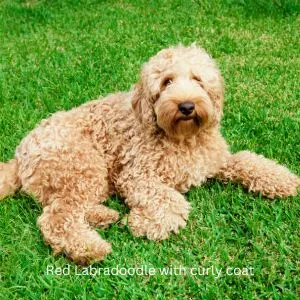
Energy Levels and Exercise
Energy Level
F1B Labradoodles often have a moderate to high energy level, reflective of both their Labrador and Poodle heritage. Labradors are known for their boundless energy and enthusiasm, while Poodles, despite being active, can be a bit more reserved. This blend results in F1Bs that are energetic and playful, yet they may be slightly easier to manage in terms of energy levels compared to some F1 Labradoodles.
Exercise Requirements
Labradoodles require regular exercise to stay in tip-top shape. A good rule of thumb is at least 60 minutes of physical activity daily. This can be divided into a few sessions to keep them engaged and prevent boredom. It’s not just about keeping their bodies healthy; exercise is also vital for mental stimulation, helping to curb undesirable behaviors that can stem from pent-up energy.
Care and Grooming
Caring for an F1B Labra doodle involves a lot of grooming. Their unique coats, which lean more towards the Poodle’s side, require regular maintenance to keep them looking their best and to minimize issues like matting and tangling. Let’s break down what it takes to keep an F1B Labradoodle well-groomed.
Grooming Needs of the F1B Labradoodle
Brushing
Regular brushing, at least a few times a week, is necessary to prevent mats and tangles, especially in areas prone to knotting, like behind the ears and under the legs.
It is important to invest in a good quality brush, like a slicker brush or a steel poodle comb, suitable for their coat type and length.
Bathing
Bathing should be done every 3 to 4 weeks or as needed, using a mild dog shampoo to keep their skin and coat healthy without stripping natural oils.
It’s also important to keep their nails trimmed, ears clean, and teeth brushed regularly for overall health and well-being.
Use a gentle, hypoallergenic shampoo, and ensure you thoroughly rinse out all soap to prevent irritation. After bathing, gently pat the coat dry and use a low-heat blow dryer to prevent dampness in the undercoat, which could lead to skin issues.
Professional Grooming:
Depending on the coat’s length and your comfort level with grooming, professional grooming every 6 to 8 weeks can help keep their coat in top shape, manage length, and address any grooming challenges.
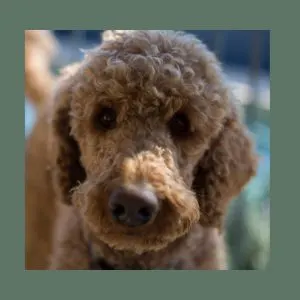
Health and Lifespan
Labradoodles are generally known for their robust health and vitality, thanks in part to the “hybrid vigor” often associated with crossbreeds. However, like all dogs, they can be predisposed to certain health issues.
Understanding these concerns, particularly how they relate to the F1B Labradoodle, can help ensure your furry friend leads a long, happy life.
Common Health Issues in Labradoodles
Labradoodles may inherit health problems common to their parent breeds. Notably, they can be susceptible to:
- Hip Dysplasia: A malformation of the hip joint that may result in arthritis or discomfort.
- Elbow Dysplasia: Similar to hip dysplasia, but affecting the elbow joint.
- Progressive Retinal Atrophy (PRA): An eye condition that can lead to blindness.
- Ear Infections: Their longer, floppy ears may trap moisture and debris, making ear infections more common.
It’s important to note that this list does not encompass all possible health issues Labradoodles might face. Preventative care is key to a long, healthy life for an F1B Labradoodle. Regular veterinary check-ups, at least once a year, are essential for early detection and treatment of potential health issues. Vaccinations, parasite control, and dental care are fundamental aspects of preventative care.
Lifespan of F1B Labradoodles
F1B Labradoodles typically enjoy a life expectancy of around 12 to 15 years, which is on par with other Labradoodle generations.
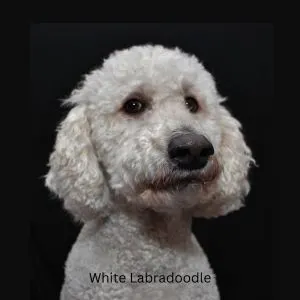
Living with an F1B Labradoodle
F1B Labra doodles thrive in environments where they can receive plenty of love, attention, and engagement. While they can adapt to apartment living, they do best in homes with a bit more space, such as a house with a yard where they can play and explore safely. However, the size of your living space is less important than the effort you put into keeping them physically and mentally stimulated. Regular walks, playtime, and interaction are key to a happy Labradoodle.
An environment that fosters social interactions and includes them in family activities is ideal. F1B Labra doodles are sociable animals who enjoy being part of the family dynamics. Without frequent interaction Labradoodles are prone to suffer from separation anxiety.
However they’re also quite adaptable, able to adjust to both active households and more laid-back settings, as long as their basic needs for affection and activity are met.
Daily Life and Routine Care Tips for Owners
Integrating an F1B Labradoodle into your daily life involves establishing a routine that accommodates their physical and mental well-being. Here are some tips for routine care:
- Exercise: Plan for at least one long daily walk, coupled with some playtime in a fenced yard or indoor games that get them moving.
- Mental Stimulation: Interactive toys, training sessions, and puzzle feeders can keep their minds sharp and engaged. I regularly play hide and seek with my doodle to keep her mentally stimulated.
- Socialization: Regularly expose them to different people, sights, and sounds to maintain their sociable and adaptable nature.
- Diet and Nutrition: Feed them high-quality dog food appropriate for their age, size, and activity level, and always have fresh water available.
- Grooming: Stick to a regular grooming routine that includes brushing, nail trimming, and ear cleaning to keep them looking and feeling their best.
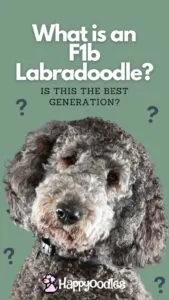
Adopting an F1B Labradoodle
Choosing to bring an F1B Labradoodle into your family is an exciting decision, but it comes with a set of considerations to ensure you’re fully prepared for the commitment. Let’s navigate through the key points on how to find a breeder that meets high standards. Plus, the significance of genetic testing and health guarantees in the process.
Finding a Reputable Breeder
A responsible breeder is crucial for ensuring you get a healthy, well-socialized puppy. Here’s what to look for:
- Transparency: A good breeder will be open about their breeding practices and happy to show you where the dogs and Labradoodle puppies live. While many breeders no longer allow in-person visits you should still be able to conduct a live video tour.
- Health Test: Look for breeders who conduct comprehensive health testing on their breeding stock for genetic diseases common to both Poodles and Labradors. Ask for copies of the results of these tests.
- Socialization: Ask about the socialization practices the breeder uses. Early exposure to a variety of people, sounds, and experiences is essential for developing well-rounded dogs.
- Support: Good breeders will offer support after you take your puppy home and be interested in the puppy’s well-being throughout its life. Ask for references.
The Importance of Genetic Testing and Health Guarantees
Genetic testing helps identify potential health issues that could be passed on to puppies. A breeder committed to the health of their puppies will have their breeding stock tested for genetic conditions like hip dysplasia, elbow dysplasia, and eye conditions.
Health guarantees are another sign of a reputable breeder. They typically cover genetic conditions and show that the breeder stands behind the health of their puppies. Be sure to understand the terms of any health guarantee, including any actions required on your part, such as regular veterinary check-ups. Also check to see how long the health guarantee lasts. Some health issues like Hip Dysplasia do not show up until one to two years old.
Is the F1B Labradoodle the Right Choice for You?
Determining if an F1B Labradoodle suits you involves reflecting on your lifestyle, space, time availability, and readiness for a long-term commitment. These energetic dogs need regular exercise and grooming to stay healthy and happy, fitting best with those who can incorporate daily physical activity and regular coat care into their routine.
Consider the size of your living space, as F1B Labradoodles vary in size and may require ample room to thrive. Additionally, they crave attention and companionship, necessitating a commitment to training, socializing, and engaging with them daily.
With a potential lifespan exceeding 15 years, adopting an F1B Labradoodle means planning for the future and ensuring you’re prepared for the enduring commitment. If you can meet these needs, an F1B Labradoodle can bring immense joy and companionship to your life.
